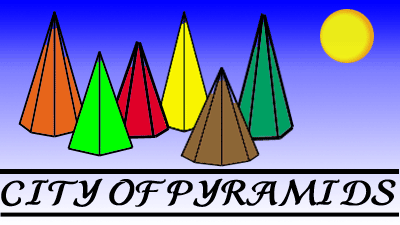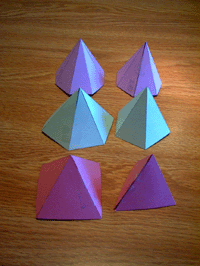

Students may work on this project individually, in groups of two, or in groups of three. Depending on their skill, this project may take from one to three periods.
|

|

|

|
Task:
From these three cards students make 6 pyramids (with open bases) whose
bases are regular polygons with 3, 4, 5, 6, 7, and 8 sides (equilateral
triangle, square, and regular pentagon, hexagon, heptagon, and octagon).
General method:
From the first card students cut out a regular 7-gon, inscribed in a
circle with a 5 inch diameter. They divide it into two parts; one
contains 3 sections of the 7-gon, and the other contains the remaining 4
sections. They fold the first section to form three faces of a pyramid
with a triangular base, and fasten them with Scotch tape. They fold the
second part, forming four faces of a pyramid with a square base, and
fasten them with Scotch tape.
From the second card students cut out a regular 11-gon, inscribed in a circle with a 5 inch diameter. They divide it into two parts; one contains 5 sections of the 11-gon, and the other contains the remaining 6 sections. They make two pyramids, one with a pentagonal base and the other with a hexagonal base.
From the third card students cut out a regular 15-gon, inscribed in a circle with a 5 inch diameter. They divide it into two parts; one contains 7 sections of the 11-gon, and the other contains the remaining 8 sections. They make the last two pyramids.
Detailed description of the first part of the task.


| Press: | See: | Mentally round to: | |
| [360][/][7][=][M+] | 51.428571 | 51 | make a mark on the circle; |
| [MRC][*][2][=] | 102.85714 |
103 | " |
| [MRC][*][3][=] | 154.28571 | 154 | " |
| [MRC][*][4][=] | 205.71428 | 206 | " |
| [MRC][*][5][=] | 257.14285 | 257 | " |
| [MRC][*][6][=] | 308.57142 | 309 | " |
| [MRC][*][7][=] | 359.99999 | 360 | you have finished marking. |


7 sided polygon |

11 sided polygon |

15 sided polygon |


|
Remarks: |